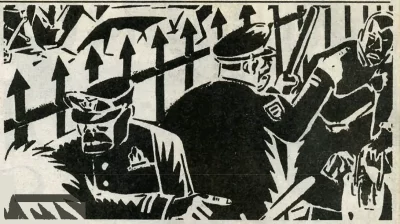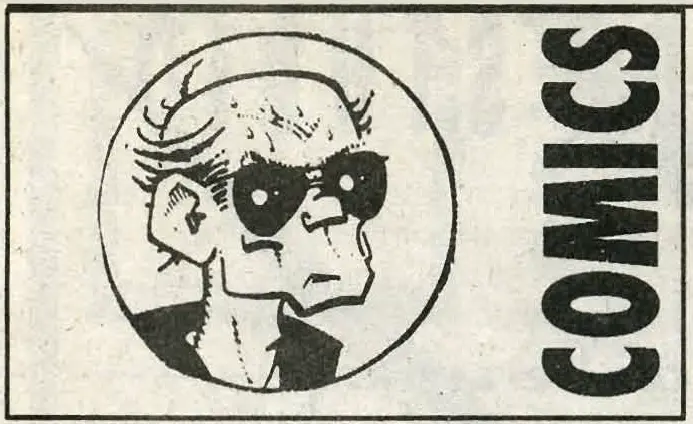Comic: April 1992
SLUGmag
Bone Saw
Two of the comics field’s more talented and lesser-known creators, James O’ Barr and John Bergin, have combined to create Bone Saw. The result is a blend of prose, sculpture and sequential art storytelling that details violence, cyberpunk, science fiction and more by O’Barr, Bergin and a host of newcomers to the field.
The eclectic contents of the first issue are highlighted by Bergin’s “Monkey Fear” and O’ Barr’s adaptation of Jeff Hollands’ short story “LSD Test Animal,” renamed “Slave Cylinder.” The latter is an admitted parody and tribute to Cyberpunk and Warner Brothers cartoons and is one of the better short comics tales your humble critic has seen in some time. O’ Barr has grown by leaps and bounds since his splash on the scene with his creation, The Crow, and fans of his work may be astonished. On the other hand, “Monkey Fear”, is far from Bergin’s best work, but it still outshines much of the other material. A vicious swipe at animal experimentation, the story displays Bergin’s admirable rendering skills.
Additional highpoints in the issue include a gallery of drawings by Gregory Bloom (which are bizarre and down beat), “Lullaby” and “Ben Gay” by Joe E. “Eddy Jersey” (which offended the less open minded readers with depictions of child abuse), “Haze” by Michael Manning (who also illustrates Misha’s “Ankoku Buto” in the issue and shows remarkable illustrative talent. Of all the newcomers included, Manning may be the one to watch), “Auto-Suggestion, Artaud’s Last Dream” (a prose fiction tale by Thom Jurek that is fascinating and revolting) and Rene J. Cigler’s “Child With Head Wound” (a delightful series of photographs sculptures).
Also, the sculpture “Railroad Man,” by Jared Pankin, used as the cover illustration, is magnificent.
Unfortunately, as with any anthology, there are lowlights. Most of these are prose works, and one in particular, “The Mimosa Sector,” a long-winded and inexplicable piece, borrows heavily from Larry Niven and Lucius Shepard with its blend of science fiction and futurism. The result is uncompelling, and worse, dull. Other failures, like “Morphine Dream #21” by Bergin and O’ Barr are at least interesting.
Overall, the result is a mixed bag. The price at $14.95 is rather inflated, but based on the first issue, Bone Saw may be one comic worth a try for those into experimental comics.
(Bone Saw #1 was graciously provided by Dr. Volt’s Comic Connection) (color / B&W, $14.95)
World War 3 Illustrated

Begun in the 1980s as a reaction against political insensitivity and lack of attention to human rights issues, World War 3 Illustrated continues its impressive run into the ‘90s.
Each issue usually has a dominant theme, and the most recent release, #15, is created mostly on the 1991 riot in Tompkins Park in New York. The resulting material is eye-opening and infuriating, especially given the way the media covered up and whitewashed the entire incident.
The most noteworthy tale on this theme is Seth Tobocman’s “Memorial Day Provocation,” which details the history of the riots, beginning with the murder of Grady Alexis, a young Haitian artist, by off-duty police officer Richard Frazier and continuing through the duplicitous closing of Tompkins Park. Tobocman’s simple, stark imagery and straight-forward narration paint a chilling picture of authority and its desire to crush ordinary humans for selfish interests.
Similarly powerful stories include Peter Kuper’s “The Jungle” (a chiaroscuro-style allegory about the artist’s musings), another in the continuing series of“Alien Metaphor” tales by Scott Cunningham. Villa Piazza’s ongoing “A New World Order” (a speculative and fascinating look at what Manhattan may be like in 800 years, provided human compassion does not die with this century) and “Survivors” (a narrative about life in Kenya accompanied by collage illustrations).
There are some lowlights in the issue, too, the notable one being “Squat N.Y.C. Chapter Two” by Lawrence van Abbema (a well drawn but naive postulation about the power of the people to overcome the police state through “squatting”), “667, Neighborhood of the Beast” by Sandy Jimenez (a useless, pandering tale of unfriendly prejudice hindered by Jimenez’s pitiful and cherished artwork) and Eric Drooker’s frankly awful poetry.
Nevertheless, World War 3 Illustrated is, as always, a wonderful call-to-arms for apathetic comics fans who may be unaware of the seriousness of our police state. As a watchdog over the encroaching tide of fascism, its usefulness cannot be undervalued.
(World War 3 Illustrated provided by Raunch) (B&W, $3.00)
Afterthought: Besides the anthology comics reviewed above, there are numerous collective comics filling the super-hero-glutted-market. Especially recommended are A-1, Drawn & Quarterly and the expensive but worthwhile, Taboo.
Also, for those of you wondering just where the cool places to buy comics are, in the following are best:
– Dr. Voltz Comic Connection, Salt Lake
– Comics Utah, Salt Lake and West Valley
– Captain Salamander’s Atomic Comic, Provo
All of these have fine selections, the employees are friendly, helpful and courteous and they’ll order just about anything with a minimum of fuss. Most importantly though, the belief that the customer is always right is stressed.
For more from the SLUG Archives:
Book Review: April 1992
Record Review: March 1992

